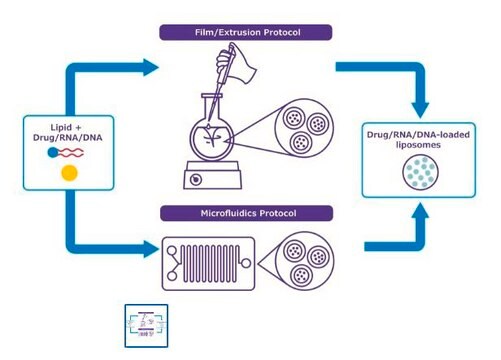915408
NanoFabTx™ PEGylated nanoparticle formulation screening kit
Synonym(s):
NanoFabTx™ reagent kit, Nanoparticle synthesis kit, PEGylated nanoformulations
About This Item
Recommended Products
description
Kit components :
PEGPLGA-50L (912808-500mg)
PEGPLGA-75L (913049-500mg)
PEGPLA-L (913308-500mg)
PEGPCL-H (912549-500mg)
Stabilizer - P (913448-10g)
Materials screening kit, for synthesis of PEGylated polymeric nanoparticles
Quality Level
application(s)
advanced drug delivery
storage temp.
2-8°C
Related Categories
General description
Application
Features and Benefits
- Provides step-by-step protocols, both for standard extrusion or microfluidic-based synthesis, developed and tested by our formulation scientists
- Microfluidic formulation development for enhancing drug bioavailability
- Flexible synthesis tool to create uniform and reproducible nanoparticles
- Optimized to make nanoparticles from 60-100 nm
- Includes 4 different PEGylated polymers to identify the optimal material
Legal Information
related product
Storage Class Code
12 - Non Combustible Liquids
Certificates of Analysis (COA)
Search for Certificates of Analysis (COA) by entering the products Lot/Batch Number. Lot and Batch Numbers can be found on a product’s label following the words ‘Lot’ or ‘Batch’.
Already Own This Product?
Find documentation for the products that you have recently purchased in the Document Library.
Articles
NanoFabTx™ platform accelerates drug development with ready-to-use formulations and microfluidic devices for particle synthesis.
NanoFabTX kits enable precise drug delivery with lipid nanoparticles and liposomes for mRNA and nucleic acids.
Professor Robert K. Prud’homme introduces flash nanoprecipitation (FNP) for nanoparticle fabrication, which is a scalable, rapid mixing process for nanoparticle formulations.
Our team of scientists has experience in all areas of research including Life Science, Material Science, Chemical Synthesis, Chromatography, Analytical and many others.
Contact Technical Service




